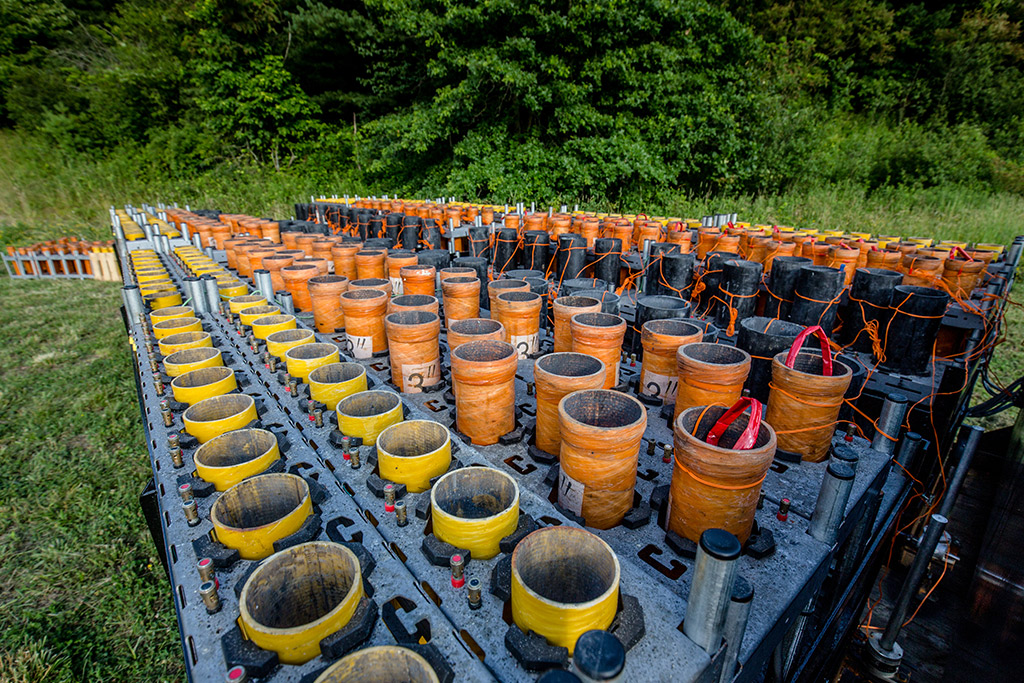What is a mortar and what is it used for?
A mortar (also called fiber tube) is a launching tube used in professional display fireworks to fire spherical or cylindrical shells (display shells). These effects are launched tens of meters into the air, where they activate and produce visual, audible, or other special effects – such as light bursts, crackling, colored smoke, or confetti. Mortars are essential not only for night shows but also for daytime displays, where movement and color dominate.
Mortars are strictly used in the context of professional pyrotechnics and are subject to specific legal restrictions. Products designed for reloading into mortars fall under category F4 and require certified professional competence for handling.
How a mortar works
The pyrotechnic effect – for example, a spherical or cylindrical shell – is inserted into the bottom of the mortar. The shell is equipped with a lifting charge that propels it into the air. A quickmatch fuse runs from the shell, allowing ignition of the bursting charge in flight.
The quickmatch may end in one of the following:
-
a green VISCO fuse – for delayed manual ignition,
-
a connector for an electric igniter – used in electrically fired systems.
In professional shows, shells are often linked together with quickmatch and delay systems to form complex choreographies. Ejection timing is precisely controlled using delay igniters (pyroclocks), which synchronize individual effects throughout the sequence.
❗ Important safety note:
Never ignite a quickmatch directly!
It reacts instantly – without any delay – and may cause sudden ejection, leading to serious injury.
What mortars are made of
Modern mortars are typically made of:
-
fiber-reinforced tubes (fiber tube) – very strong and lightweight, they don’t shatter upon failure,
-
HDPE plastic – heavier and often used for larger calibers.
Metal mortars are no longer commonly used due to the shrapnel risk in case of malfunction.
📏 Various calibers and correct usage
Mortars are made in a range of calibers, which must exactly match the size of the shell. Common diameters include:
-
2″ (50 mm)
-
2.5″ (63 mm)
-
3″ (75 mm)
-
4″ (100 mm)
-
and larger
⚠️ Important rule:
A 3″ (75 mm) shell must be fired from a 3″ (75 mm) mortar.
Even if it physically fits into a 4″ mortar, mixing sizes is never allowed!
Using an oversized mortar can result in unstable ejection, altered flight path, or failure to ignite, all of which are extremely dangerous.
Dangers of reloading mortars
In some displays, reloading is practiced – where a second shell is inserted into the same mortar after the first one has been fired. However, this technique is very risky, and is being phased out in favor of using multiple fixed mortars.
After a shell is launched, hot debris (such as remnants of quickmatch) may remain in the tube. If a new shell is inserted while hot particles are still present, it may ignite immediately, without warning. This is particularly dangerous if residual smoke blocks visibility and the bottom of the tube isn’t clearly visible.
That’s why mortars must always be emptied and checked after each shot.
Stand to the side of the mortar when working near it – never lean over the opening.
Why paper mortars are no longer made
In the past, consumer kits were sold that included a few spherical shells and a paper mortar. These were often placed in snow or soft ground. However, after the first shot, the tube would heat up and absorb moisture from the ground or snow. This could cause the paper mortar to weaken or collapse, leading to rupture and injury upon subsequent firings.
These paper mortars were deemed unsafe and are no longer manufactured or sold.
Summary
Mortars are critical tools in professional pyrotechnics, allowing safe and precise launching of aerial shells. However, their use demands high-level training, technical understanding, and strict adherence to safety protocols.
Mortars and reloadable products are legally reserved for certified professionals only and are not available for public sale.

